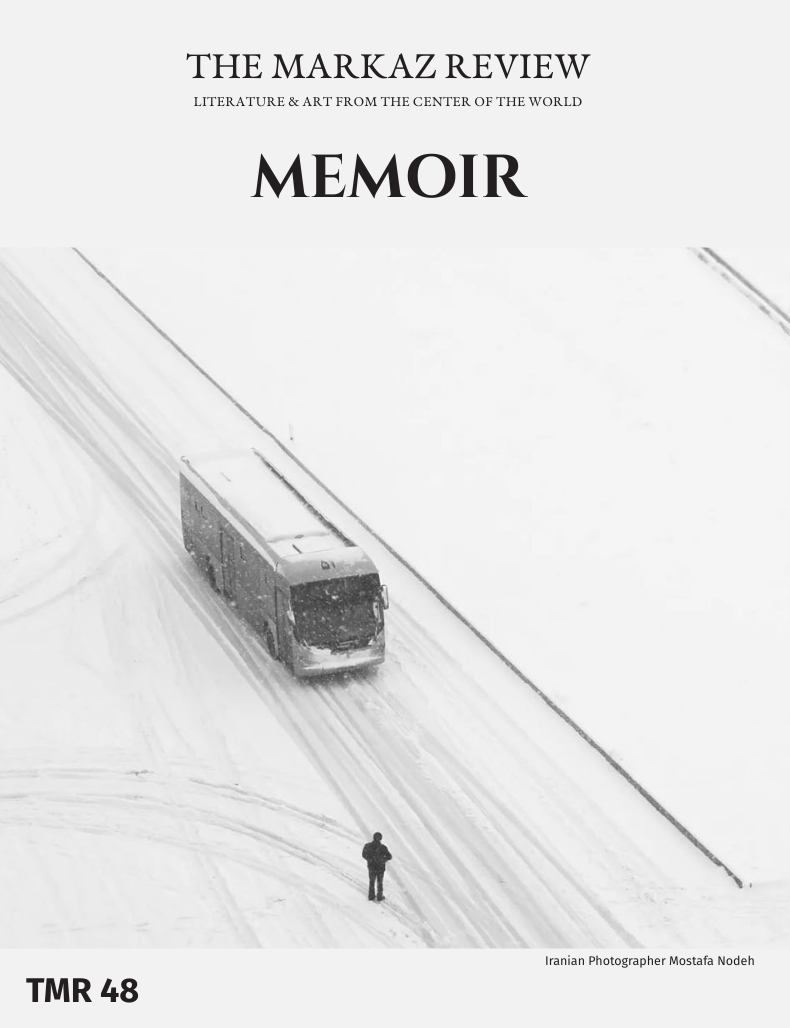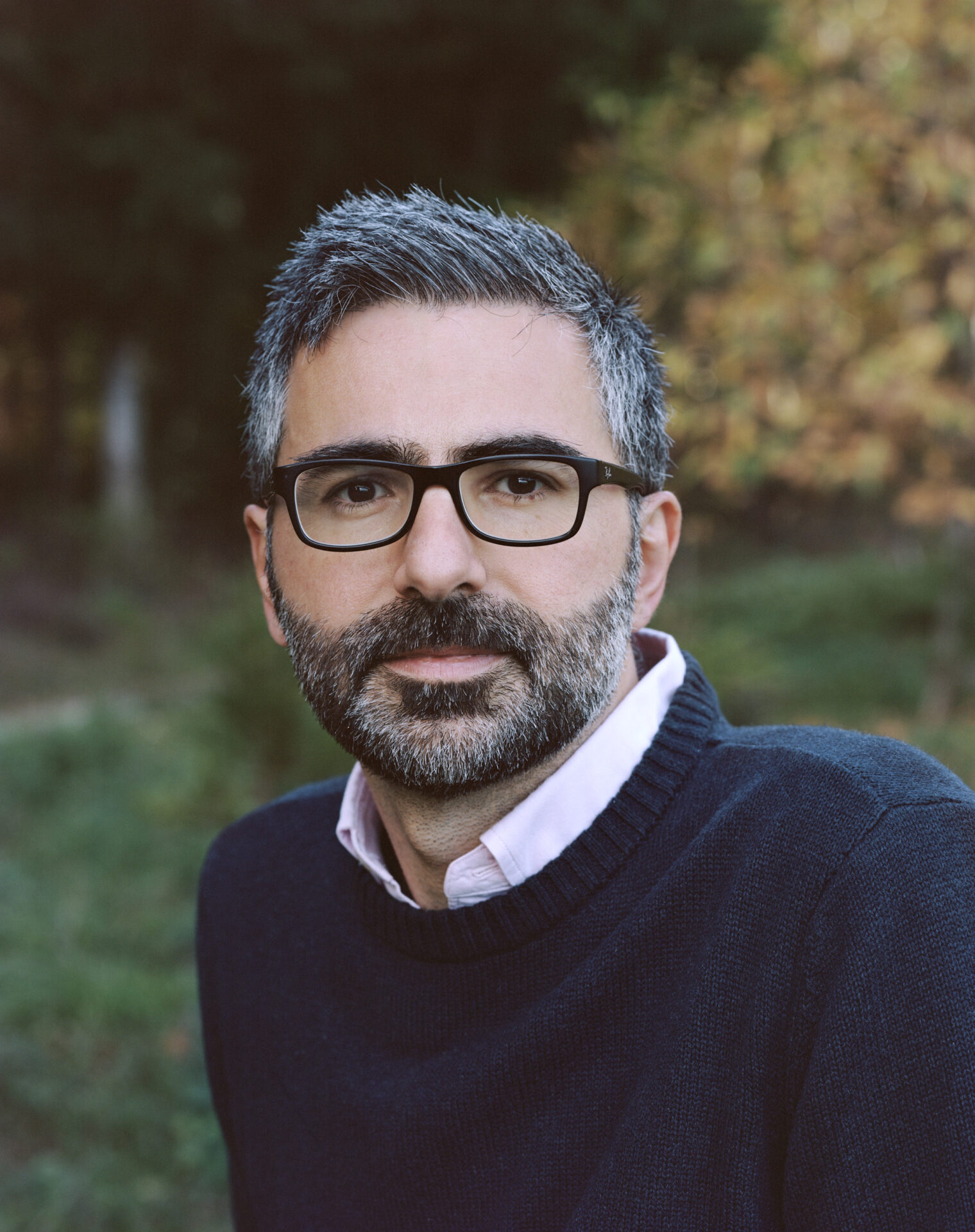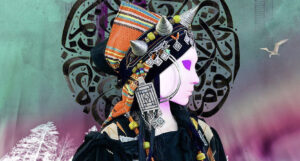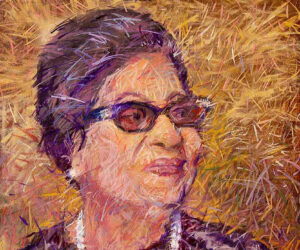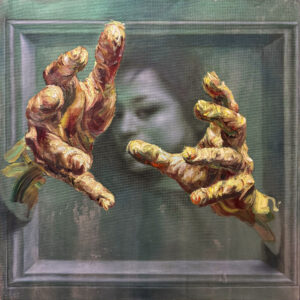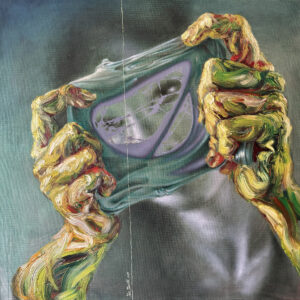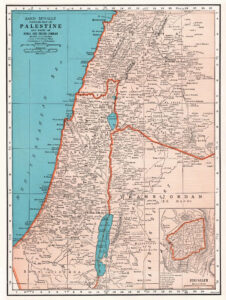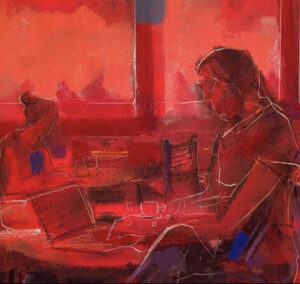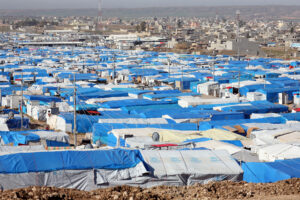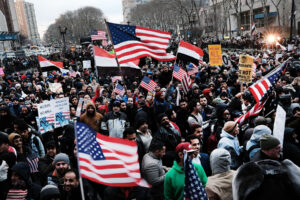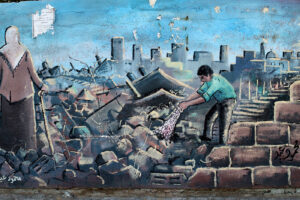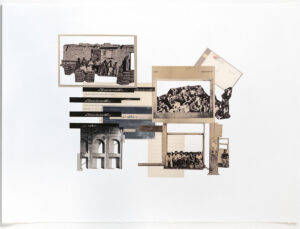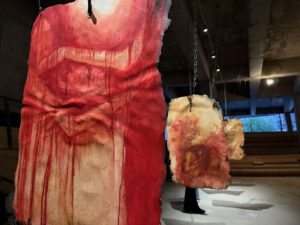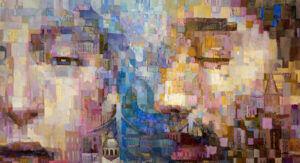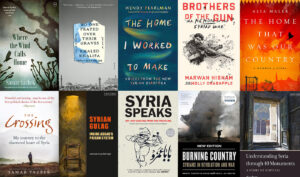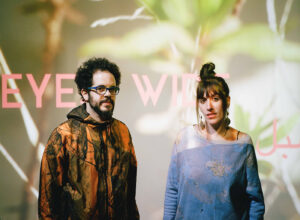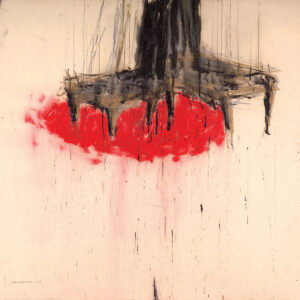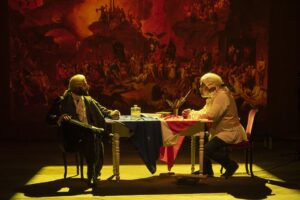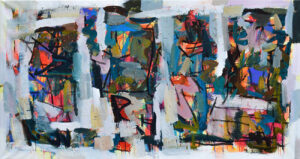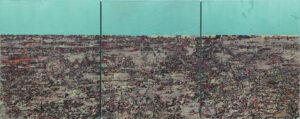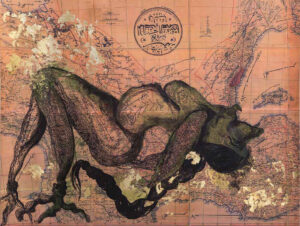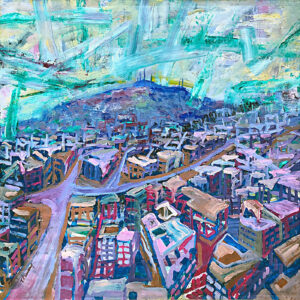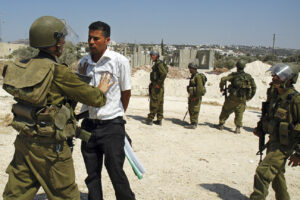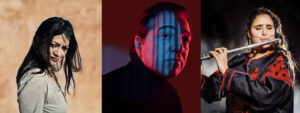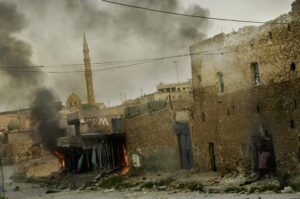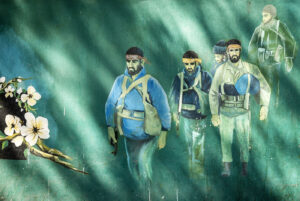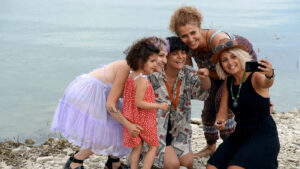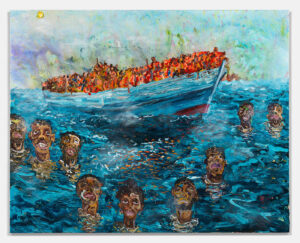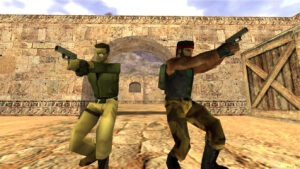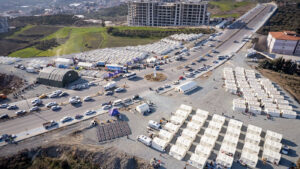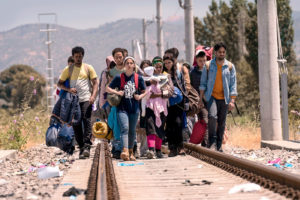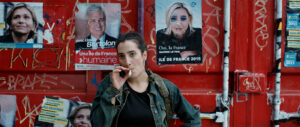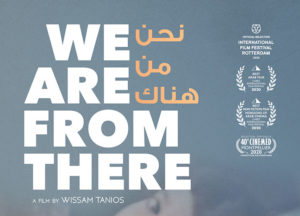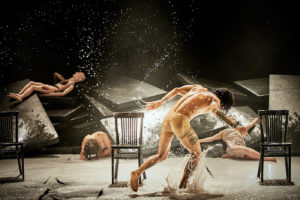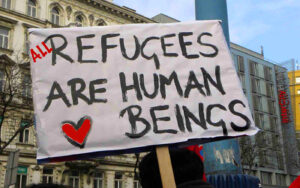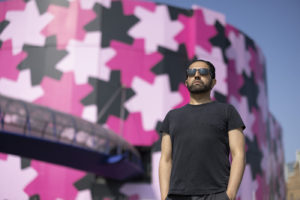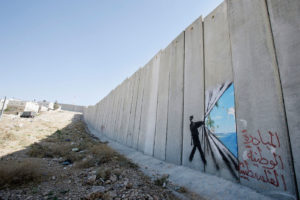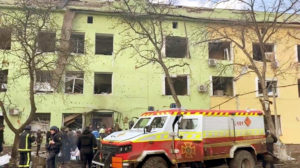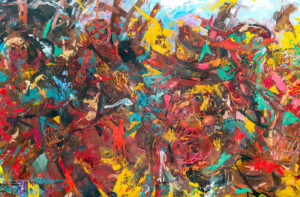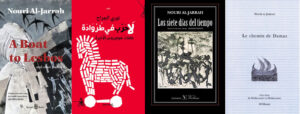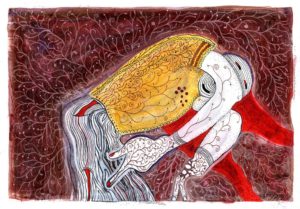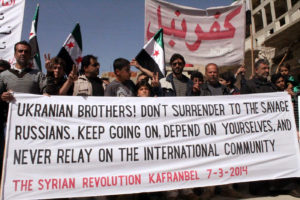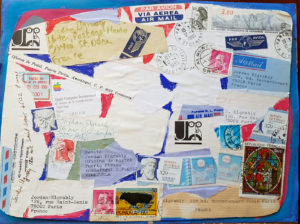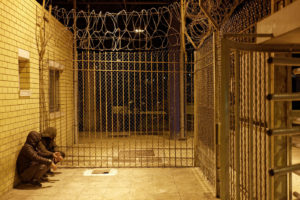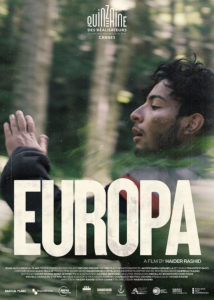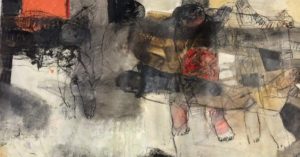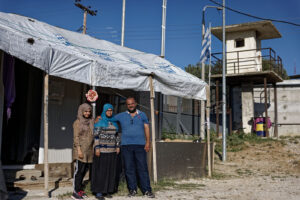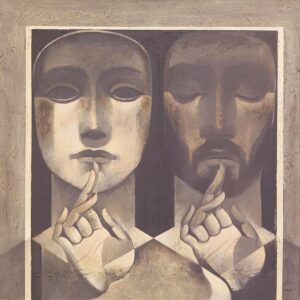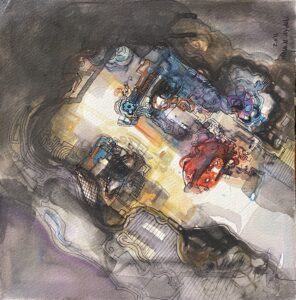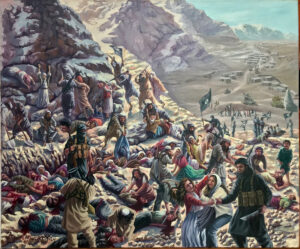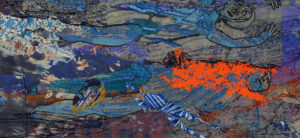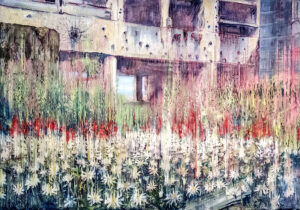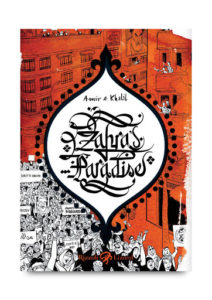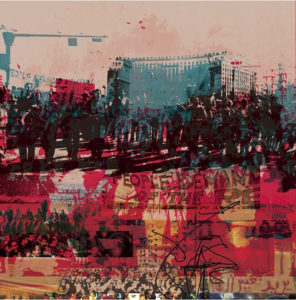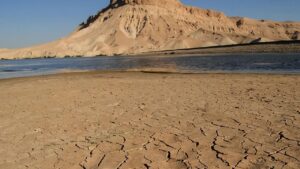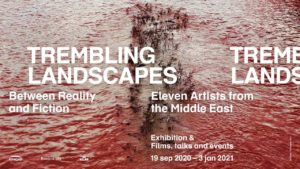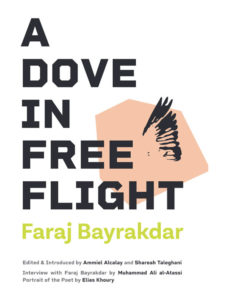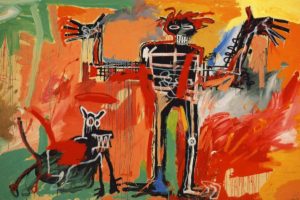After being away for 13 years, writer and translator Odai Al Zoubi reflects on his first trip back to Syria. He finds himself revisiting the Hanging Mosque and the Barada River, where he reconnects with a sense of lost time and place.
“Return to me, o’ conjuror of promises, like a Damascene breeze over Barada,” sings Fairuz. The Barada River flows quietly unacknowledged through the city of Damascus, in stark contrast to the celebrated verses of poets like Al-Buhturi, Ahmed Shawqi, Nizar Qabbani, and Saeed Akl —who was a friend of Fairuz and the writer of the poem to which these lyrics belong. The river stands as though aloof, detached from the city’s development, its lively urban landscape, and the significance all this implies. Nowadays, the river evokes a deep melancholy in people’s hearts, reminiscent of the nostalgia stirred by faded black-and-white photos or the warm, comforting embraces from cherished grandmothers. It conjures the fragrance of dried mint and stirs a yearning for elusive memories, peculiar and uncertain.
I arrived in Damascus after an absence of 13 years humming that well-known song— about Barada, wasted promises, swords and suns, and the passions of the Levantine. And yet, the river ebbed and flowed, just as it had during my absence and as it did now in my presence, while I recklessly tried to capture the elusive: the past, the fleeting essence of poetry, and the bygone times of a war that had now drawn to a close.
I begin at al-Maalaq Mosque (also known as the Hanging Mosque). I stand at its main entrance. Two small steps lead up to it. The wooden door is ancient and decorated with concise geometric patterns. Finding it locked, I make my way to the smaller door adorned with charming Iberian Mocárabe detailing. This, too, is locked. The street is bustling with blacksmith shops and similar establishments. I’m situated on King Faisal Street, where the street and the mosque lie just outside the old city walls, whereby a network of side streets connect it to the heart of the old city. The houses and shops are dilapidated, reflecting years of neglect. I spot a small iron door that looks like it belongs to a modest home, with the name of the mosque inscribed above it. I hesitantly step inside, pass the sleek wash areas designed for ritual cleansing, and enter the mosque’s central courtyard.
The mosque, perched on arches that are not visible from here, overlooks the Barada River, located along one of today’s busiest streets, far removed from the charm of urban aesthetics. It was designed to intentionally distance it from the nearby schools, mosques, and palaces scattered within the walls and throughout the Salihiyya and Kurdish neighborhoods. Our river flows beneath, nourishing the mosque like a rose in perpetual bloom. Yet, the fountain stands still, and the basin in the courtyard has dried up, suggesting that our faith, much like the Barada River, and the freedoms we’ve recently attained are on hold until further notice. I approach cautiously. The fountain is nestled among plants in old tins, giving the impression that it belongs to a bustling family home. I walk around, captivated by the variety of the successive colored stones on the walls: black, off-white, black, ash pink, and then back to black. The splashes of rose color uplift the spirits, the fractured country appearing to cling to the hue for survival. Before me lies the prayer hall, while ablution stations flank my right and left sides, awkwardly cut off from the courtyard by unsightly glass barriers that jar with our antiquated mosques. I enter the mosque, trailed by a young man who has been watching me. The pulpit features intricate geometric wood carvings, drawing the eye with captivating designs. In contrast, the mihrab is constructed from modern marble and is accented with unappealing green lights. The renovation in this place leaves much to be desired; everything is painted a stark white, even the ceiling. From the window, Barada is visible as a narrow dirt-filled stream winding its way through the aged houses of a dilapidated and polluted city. I return to the mosque’s courtyard, and the young man follows me. Above the main entrance, on the right side, laundry hangs out to dry, as the mosque houses the Imam Abu Hassan Shazly Institute for Religious Studies.
The young man approaches me and nervously asks what I’m doing there. I don’t have a clear answer. I’m searching for Barada, I mumble under my breath. His doubt intensifies. I share my name and profession and list my published books, but the unease lingers. He tells me that he is from Hama and is currently studying here. He doesn’t know anything about the mosque’s history, why the main door is locked, or the details about the dry fountain. I sigh, frustrated. The sun is shining. The Clementine tree (Yusuf Effendi) stands alone in the corner, bursting with life and bearing fruit, lending a cheerful splash of color to Damascus, Islam, and my spirit. The main door is prised shut from the inside, with old carpets, several cupboards, and broken bicycles leaning against it. I feel a fleeting sense of peace and recite a passage from the Holy Quran: “Enter this village and eat from it plentifully as you please, and enter the gate in submission and speak with humility. We would then forgive you your sins. We will certainly increase further for the good-doers.“— Surah Baqarah [02:58]
I step outside and head toward the second platform to take photos of the short, wide, octagonal minaret, which lacks a dome on top. Nearby, two young men gently poke fun at me for looking like a typical foreign tourist, snapping pictures of everything. We strike up a conversation about the minaret before I continue to the bustling Al-Manakhiliyah market. Following the river, I walk along the edge of the old wall beside the citadel, my thoughts drifting to the intimate Mamluk mosque, reminding me that Damascus owes its rich Islamic urban architecture primarily to the Ayyubids and Mamluks. I drag along my scattered thoughts like the haphazard objects strewn across the mosque’s courtyard: What does history signify for the future of a country that swings between former jihadists governing us with unexpected tenderness and Fairuz’s enduring melodies of Damascus that continue to echo everywhere? What is it about the Mamluk era that features crushed stone braids and spiraling columns similar to those found in the mosque amid its humble surroundings? Do we wait for the grand entrance to open, or is the smaller door sufficient for our needs?

Thousands of rural residents have converged on Damascus, setting up stalls selling everything imaginable. Most of these vendors hail from the countryside of Idlib and Aleppo. Meanwhile, two armed men from the liberating faction sit idly by, observing the scene. Since the liberation, tens — if not hundreds — of thousands of rural people have flocked to Damascus, a city previously off-limits to them. Children scramble up the statue of Saladin and his horse at the castle entrance, snapping pictures. It feels like judgment day, jokes a sheikh trying to navigate across Hijaz Street alongside me. Kindness and politeness are everywhere. Happiness radiates from every face. Unlike the countryside, which suffered devastating bombings by Russian and Assad forces, Damascus itself remained unscathed. It’s hard to grasp the fluidity in a troubled country that lacks law and order, where the lines between revolutionary and constitutional legitimacy are often blurred. The crowding is intense, and some are grumbling about the newcomers. I enter Marjeh Square through a side street. The Barada River flows beneath the surface before reemerging here, in this spot. I follow its path, at a loss to make sense of it.
Marjeh Square leads directly to a prominent column, often called “The Shaft.” This bustling square is surrounded by a mix of architecture: the elegant Al-Abed building, next to a smooth, rounded Italian design building, a strikingly unattractive modern structure, the Yalbugha Mosque, and a mall that is currently under construction. The traffic here is quite congested, with various money changers and cobblers scattered throughout. It was the first time I noticed a model of a mosque perched atop the head of the shaft, which I later discovered is a replica of the Yildiz Mosque in Istanbul. Faded and peeling posters of the missing compete for space on the column. I approach it with trepidation. Just a month has gone by since the liberation, yet their faces have nearly vanished from the heart of the capital.
I observe more rural individuals dressed in luxurious gowns, exhibiting gentle demeanors. Among them are former fighters sporting long hair, following the teachings of the Prophet Muhammad. Pigeons take to the sky as the weight of history hangs in the air. The Ottoman conquest, which began with a significant urban economic revival, culminated in the execution of Syrian anti-Turkish fighters in this very square on May 6, 1916. The Barada River flows slowly, as if reluctant to carve its path through the square, stripped of any real choice in the matter. With hardly any trees in sight, the square features a small network of paths lined with stalls leading over the river. Once again, the pigeons take flight, appearing blissfully unaware of everything around them. What sticks with me most from my childhood in the square are those pigeons circling happily and aimlessly, just as they do today. Over the years, the square’s numerous hotels have gradually transformed into brothels catering to pimps and prostitutes, all in the shadow of the Ministry of Interior. I remember visiting one of those places when I was sixteen —a disastrous encounter that ended with a somewhat comedic escape. As the third millennium dawned, these establishments were pushed out to the suburbs. I can’t help but notice the palm trees; they appear unbalanced, with towering ones standing beside stunted dwarfs, their limited presence hardly enough to fill the eye with lush greenery. At the corner of the square, a majestic eucalyptus tree stands tall, serving as a soothing balm for the weary spirit. Nowadays, the area has transformed into a gathering place where rural families flock to hotels and the relatives of missing persons from both Assad regimes come together in grief, seeking answers to questions that may remain forever unanswered.

I follow the Barada River. It goes underground and then comes back up after the Revolution Bridge. Two horses cross my path, looking nervous and spooked by their surroundings. I see a young man in a red sweater, like Westerners wear at Christmas. To my right stands the Four Seasons Hotel, once a stronghold for the corrupt under the previous regime and now a venue for the security meetings of the new administration. The structure’s unsightliness both conceals and reveals the city around it. After a cursory glance, I press on with surprising resolve. I stroll alongside the river, where the path widens — trash piles up like a polluted stream in a forgotten town. More stalls take shape along the way, adding to the scene. Beggars lay about in the hundreds. The last time the Barada River overflowed its banks was in 1988. I was just seven years old then, and schools had to shut down. It was a cold spring, as the river flows in the spring rather than in winter. I approached a beggar girl, asking for her name and where she was from. She looked at me with disdain and simply didn’t reply. She sighed when I handed her a thousand liras (barely ten cents). Forcing a smile, she tucked the money away, disinterested and bored.
I walk into the National Museum, which overlooks the river. I’m greeted by the statue of Hadad/Baal standing tall at the entrance. Its iconic headdress and bulging eyes tower above me; the statue is slightly larger than a person and remains completely intact, yet no information accompanies it. Today marks its first day back to work since the liberation. The employees are in a state of disarray. The small café nearby buzzes with young people chatting animatedly. I find a seat and listen in on a group of archeology students debating the future of our country: a civil, Islamic, or secular state; idols and statues; restoration of monuments. Their enthusiasm is infectious, but it’s not for me. I enter the museum, unsure of my steps. The museum’s gate comes from the Al-Hirah Palace, one of the renowned Umayyad palaces. I delve into the classical eras, beginning with the arrival of Alexander the Great, whose expansive empire eventually fell, and Syria was relegated to the Seleucid dynasty. After that came the Romans, who established a vast aristocratic empire while undergoing a significant transition to Christianity. The Byzantine era followed next. The statues embody a puzzling interpretation of art; some exude a certain dullness and roughness alongside a raw, almost luxurious Aramaic quality. This stands in stark contrast to the graceful movement found in Greek and Roman sculptures. Some are a mixture of both. I find the depiction of divine perfection in human forms unappealing. Instead, I am drawn to something different — a statue of an ordinary woman from northern Syria, similar to the one in front of three mosaic panels. This figure doesn’t strive for perfection; rather, it embodies the essence of everyday humanity. As I stand before it, I feel as though I’ve united with what I seek in the universe: a beautiful blend of the rugged charm of the local Aramaic culture infused with Greek fluidity, all devoid of the idealism often associated with deities.
The mosaic on the floor showcases two peacocks, various birds, plants, and a small cross, with no human figures in sight. The number of visitors is small, mainly students of history or archaeology and those arriving from the countryside to experience a museum for the first time. Their joy is palpable, and it fills me with happiness. They rescue me from thoughts that lead nowhere regarding the most peculiar era in Syrian history: what Westerners refer to as the classical period. During this time, Syria became intertwined with empires that were both profoundly connected to it and yet maintained their distinct identities.
A girl in her early twenties is trying to convince her husband to snap a picture of her at the Palmyra cemetery. Her pose perfectly mimics a relief drawing of a girl in a veil amid gravestones, and they look nearly identical. Although her husband grumbles, as I tend to do when asked to take a photo, he eventually gives in. As I leave the cemetery, I feel a flutter in my soul, yearning for a different, more serious, and vibrant life that feels just within reach.
Since the days of the former regime, all sections of the museum have been shut down: prehistoric times, ancient eras (pre-classical), Islamic periods, and even modern history. What’s left is a puzzling mix of classic, charming, and somewhat annoying exhibits. I walk away, feeling frustrated and aimless. As I wander through the garden, I pass by scattered antiquities from various eras. The small fountain sits dry while the clementine trees flourish vibrantly. The park buzzes with pairs of lovers: students puffing on cigarettes, modern girls without headscarves chatting with laid-back guys sporting long hair, and modestly veiled women alongside confidently swaggering boys. I move through the crowd, acutely aware of my loneliness. Christian, Islamic, Aramaic, Roman, and Greek monuments lie haphazardly scattered about, embodying the rich tapestry of civilizations surrounding the lovers who seek refuge from the chaos of war, liberation, and the quest for freedom in a lush, serene park tucked away amidst one of the busiest streets in Syria. As I take my leave, I bid farewell to Hadad, the quintessential Syrian god of rain and storms, who stands majestically, safeguarding the museum, the lovers, and the garden.
I head to the cafes in Al-Rabwah on the city’s outskirts. The taxi driver plays Nancy Ajram’s song: “Hubbak Saffah, mojrim wi shayilly slaah.” The lyrics contrast sharply with the lively beat. The cafés, all with a view of the river, vary widely — from upscale restaurants to cozy, popular spots. I spent countless evenings there during my teenage years and early adulthood. It feels like nothing has changed. Workers in affordable restaurants welcome me warmly and laugh openly at my questions. To them, I seem like a foreign expert when I ask them about what has changed: the war, Bashar, liberation, and their feelings. I visited the places I was familiar with: “Al-Shaar” and “Al-Ajlouni.” Everything felt unchanged there: the railway, where no trains have run since the sixties, the white plastic chairs, and Umm Kulthum’s voice cutting through the air with a familiar edge: “Tifeed bi eh ya nadam! Ou ta3mel eh ya 3tab!” I could see the tired faces, hear the arguments over card games, and notice the doors — glass with jagged edges patched up with newspaper. The lamps buzzed sporadically, and authentic, freshly brewed tea warmed trembling hearts. One might find it hard to believe that war ever touched this place, that time moved on, or that the absence of meaning exists altogether, along with the sly whispers of a predatory devil who deceives men into believing in false courage and masculinity. Yet, here they are, the good-hearted, who simply escape from it all, seeking refuge for a few hours in cafés where no woman has ever set foot.
Barada flows here with a smoothness and momentum that surpasses what I’ve seen in the city, despite its smaller size and winding course. The nearby houses seem almost on the verge of collapse as if shaken by an earthquake; this has been the scene since I first visited in the mid-nineties. Yet, they’ve held on, remaining vibrant and full of life, even carrying a hint of sourness, while Barada entertains them with soft whisperings — perhaps with tales about the passage of time.
The electricity has been cut off, and the noise of the generator and the pungent smell of diesel quickly shatter any romantic illusions about this place. It’s nothing like what you’d find in great poetry. However, the introduction to Fairuz’s song “Murra bi” conveys a more delicate and uncertain tone skilfully expressed through the exquisite melody of Mohamed Abdel Wahab, which he crafted in homage to the grandeur of the Barada River — a sharp contrast to the typical expressions of national pride. At that moment, I allow myself to indulge in a fleeting sense of joy as I return to my city, hearing the words: “Murra bee, ya wa3idan Wa3dan, mithlama alnasma min Barada, tahmil al3mr tobadidoohoo.”
Thirteen years. Shattered windows. Shouts and insults. The haze of hookah and cigarette smoke. A persistent ache in my right shoulder that defies remedy. Wilted willows bent in idle ennui, and happiness intertwined with sorrow, echoing the balance of yin and yang. And Fairuz’s voice soars on, her gentle tone clashing with the poignant lyrics that speak of a longed-for return, the ache of absence that precedes it, and the uncertainties that lie ahead: “How sweet they are, one and all!” she sings.




